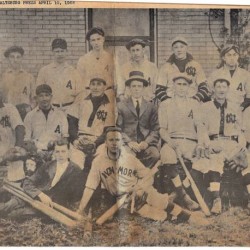
AVONMORE’S EARLIEST SETTLER
Standing over 7 feet tall, Stephen Rinebolt, born in Amsterdam Holland in 1710, was a son of a prominent family. As a young man in his 20’s, Stephen and his family fell victim to his and his family’s political and religious affairs. As the family planned their escape it was agreed that Stephen would escape the new British colony. This new colony was known for its political and religious freedoms.
In 1734 Stephen landed in Philidelphia and received an unlimited land grant from the Penn family. The specific land was his choice. However, the land he had to choose from was on the other side of the Allegheny Mountains, nearly 400 miles from Philidelphia. Determined to survive and succeed, young Rinebolt made his way across the expanse of what is known Pennsylvania. He survived this trip alone, learning the skills he needed to survive along the journey. Finally, he came to an area, flat and wide along the banks of the modern day Kiski River nestled in the upper Kiski River Valley that he found satisfactory. For the period, it was a typical plot of Pennsylvania wilderness, densely forested and where no white man had settled before. Rinebolt described the limits of his chosen tract of land, on which he entered his grant. It included the line commencing at the confluence of the ‘Big Run’ with the Kiski river (just near the current day Salina bridge), then west to near Tinsmill, from there to the Kiski River on, or near, a point opposite the mouth of the Blacklegs Creek. The majority of that land is modern day Avonmore.
At that time, along the banks of the Kiski River, were small villages that had been established by Native Americans. However, Rinebolt was the first white settler in the area, possibly even the first European settler in southwest Pennsylvania. Right here in Avonmore PA. Nestled on the ‘hogs back’ that overlooks Avonmore from its western boundary was the first settler’s home. The home was a rustic log cabin that the over 7 foot tall Hollander built on his own! For the next 20 years Rinebolt spent his time tending to his small garden (planted with seeds he brought with him from his home) with his only companion a dog. He was visited occasionally by the friendly, neighboring, Native Americans.
After that period of time Rinebolt returned to Holland. However, the animosity towards his family had not yet passed. After only a year in his homeland Rinebolt returned to his adopted home, the Kiski River Valley. But, before leaving Holland he offered a portion of his new homestead to 10 families of relatives and friends. Many of those names are still familiar in the area; Taylor, Rumbaugh, Hine, Huff, Bash, Frick, Kunkle, Learn, Townsend, Ringle, and Ulam. Many years later Mrs. Robert Townsend told her grandchildren how Stephen Rinebolt came to visit the Townsend’s new home bringing with him pears next to his body in his shirt. All white people, without exception, believed that he was their protection from the treachery of the Indians, his only friends in his early years in the Kisky River Valley. When the Indians approached him as they were in the habit of doing, they brought him meat and other peace offerings. These visits were frequent and accomplished with awe and reverence.
Anne Royall, in her travel account of 1828, reminisced about the hermit Stehpen Rinebolt coming to visit her family in their log cabin on the hill overlooking the Loyalhanna near the present location of the Kiski Prep School. Rinebolt brought with him gourds filled with salt, which he gave away as presents. All this happened prior to the revolutionary war. So, Rinebolt may have been the earliest white settler to produce salt in Western Pennsylvania. In the 1820’s the Kiskiminetas Salt Works grew up in the Salina-Edmond area (at the western most edge of Rinebolts land). This was also where Rinebolt sourced his salt.
It was said the Rinebolt had ‘a winning countenance, a pleasing personality, but a fiery temper. He was revered by all around him, Indians and white settlers alike’. Rinebolt died at 105 years of age and was buried in the Hines cemetery in Avonmore.